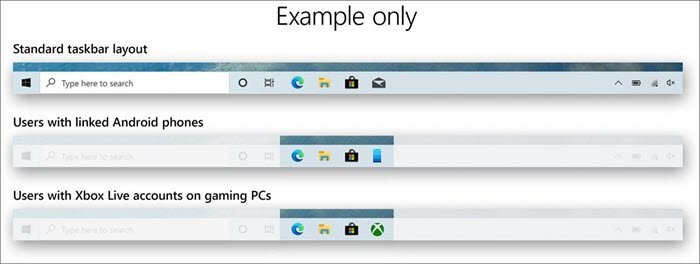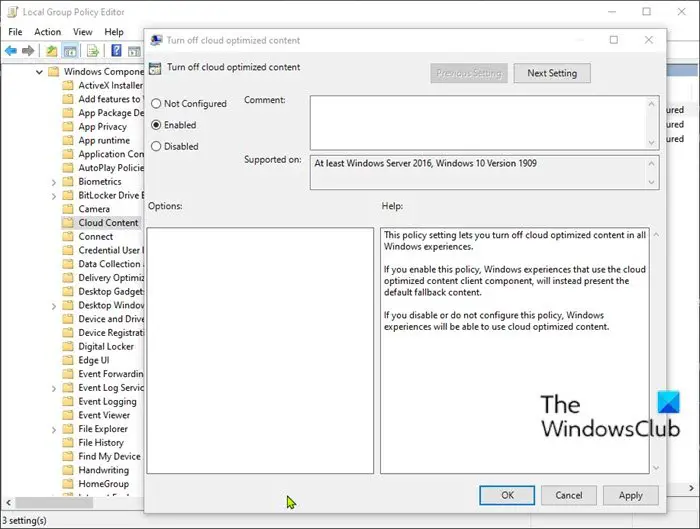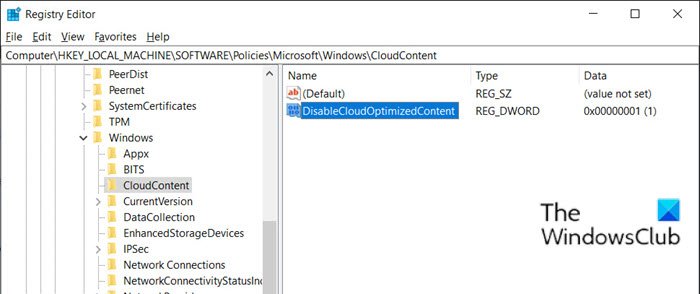In Windows 11/10, Microsoft has now added a new group policy that allows you to disable a new feature called Programmable Taskbar – that customizes the taskbar based on what accounts or devices you have. In this post, we briefly describe this feature and show you how to disable the feature in Windows 11/10.

The Programmable Taskbar is a new cloud-based feature that will add different pinned programs on the taskbar depending on what types of accounts a user has or what devices are linked to a computer. The image above illustrates how the cloud-based Programmable Taskbar feature will modify the default taskbar based on whether users on the device are linked to Android phones or have Xbox Live accounts.
Disable Programmable Taskbar in Windows 11/10
This feature is live in Windows 10 20H2 and later and in Windows 11 too. It does not modify the taskbar for any existing accounts, but only for new accounts or accounts logging in for the first time.
For those who wish to always use the default Windows taskbar, you can disable the Programmable Taskbar feature in either of two ways;
- Via Local Group Policy Editor
- Via Registry Editor
Let’s take a look at the description of the process in relation to each of the method.
1] Disable the Programmable Taskbar feature via Local Group Policy Editor

Do the following:
- Press Windows key + R to invoke the Run dialog.
- In the Run dialog box type
gpedit.mscand press Enter to open Group Policy Editor. - Inside the Local Group Policy Editor, use the left pane to navigate to the path below:
Computer Configuration\Administrative Templates\Windows Components\Cloud Content
- On the right pane, double-click on Turn off cloud optimized content to edit its properties.
- In the properties window, set the radio button to Enabled.
- Click Apply > OK to save the changes.
This policy setting lets you turn off cloud optimized content in all Windows experiences.
If you enable this policy, Windows experiences that use the cloud optimized content client component, will instead present the default fallback content.
If you disable or do not configure this policy, Windows experiences will be able to use cloud optimized content.
If you wish to restore the feature at any time, just repeat the steps above, but this time, set the radio button to Not configured or Disabled.
For Windows Home users, you can add Local Group Policy Editor feature and then carry out the instructions as provided above or you can do the registry method below.
2] Disable the Programmable Taskbar feature via Registry Editor

Since this is a registry operation, it is recommended that you back up the registry or create a system restore point as necessary precautionary measures. Once done, you can proceed as follows:
- Press Windows key + R to invoke the Run dialog.
- In the Run dialog box, type
notepadand hit Enter to open Notepad. - Copy and paste the code below into the text editor.
Windows Registry Editor Version 5.00 [HKEY_LOCAL_MACHINE\SOFTWARE\Policies\Microsoft\Windows\CloudContent] "DisableCloudOptimizedContent"=dword:00000001
- Now, click the File option from the menu and select Save As button.
- Choose a location (preferably desktop) where you want to save the file.
- Enter a name with .reg extension (eg; Disable_Prog_Taskbar.reg).
- Choose All Files from the Save as type drop-down list.
- Double-click the saved .reg file to merge it.
- If prompted, click on Run > Yes (UAC) > Yes > OK to approve the merge.
- You can now delete the .reg file if you like.
If at any time you wish to restore the feature, do the following:
- Press Windows key + R to invoke the Run dialog.
- In the Run dialog box, type regedit and hit Enter to open Registry Editor.
- Navigate or jump to the registry key path below:
HKEY_LOCAL_MACHINE\SOFTWARE\Policies\Microsoft\Windows\CloudContent
- At the location, on the right pane, double-click the DisableCloudOptimizedContent entry to edit its properties.
- In the properties window, set the Value data to 0.
- Click OK to save changes.
- Restart your computer.
That’s it!